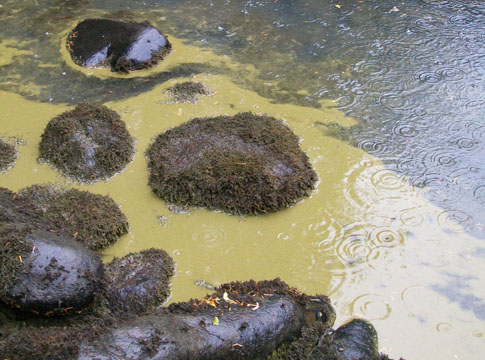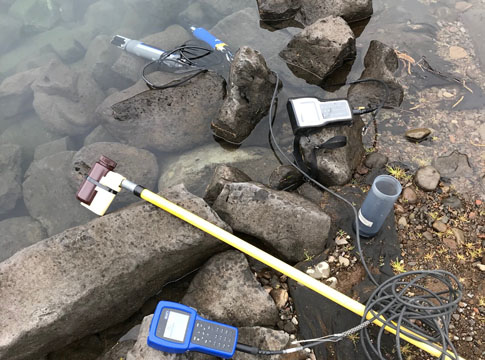How are cyanobacterial blooms formed?
Why are some cyanobacterial blooms harmful?
How do cyanotoxins affect drinking water quality?
What does EWEB do if toxins are detected?
At what levels do cyanotoxins in drinking water become a health concern?
What are the health effects in humans and animals from exposure to cyanotoxins in drinking water?
Are sensitive populations or infants fed by nursing mothers at risk?
How do cyanotoxins affect my pets?
Are there filters I can use to remove cyanotoxins from my tap water?
How do I protect myself, my family, and animals from cyanotoxins?
What does a cyanobacterial bloom look like?
How can people and animals come in contact with cyanobacteria and cyanotoxins in the environment?
What are the health effects in humans and animals from exposure to cyanotoxins in the environment?
How can I help reduce cyanobacterial blooms from forming?
For more information on cyanobacterial blooms and cyanotoxins, please visit:
What are cyanobacteria?
Cyanobacteria are photosynthetic bacteria that are found naturally in lakes, streams, ponds, and other surface waters. Under certain conditions, cyanobacteria can rapidly form blooms that spread across the water's surface. Blooms that impair water quality or generate toxins that are harmful to humans and animals are generally referred to as cyanobacterial harmful algal blooms (cyanoHABs).
How are cyanobacterial blooms formed?
Cyanobacterial blooms form when cyanobacteria start to multiply very quickly. Blooms can form in warm, slow-moving waters that are rich in nutrients (high in phosphorus and nitrogen). Nutrients can enter lakes and rivers from natural sources, such as volcanic rock and forests, or from man-made sources, such as fertilizer runoff, stormwater outfalls, septic tank overflows and pet waste. Cyanobacterial blooms generally need an abundance of nutrients to grow.

Why are some cyanobacterial blooms harmful?
Cyanobacteria in cyanobacterial blooms may produce toxins called cyanotoxins. These toxins can affect people, their pets, other animals and the environment. Unfortunately, there are no remedies to counteract the effects.
- The blooms can block or reduce the sunlight that other organisms need to live.
- They use up nutrients that other organisms need to live.
- They use up the oxygen in the water as they die down.
How do cyanotoxins affect drinking water quality?
Cyanobacterial blooms that create cyanotoxins can occur in source waters (e.g., lakes or rivers) that are used to supply drinking water. The McKenzie River can transport toxins from upriver reservoirs to the drinking water intake at the water treatment plant. If cyanotoxins are not removed during drinking water treatment, people can be exposed to cyanotoxins through their tap water. Cyanobacteria may also produce taste and odor compounds that could cause problems in drinking water.

What does EWEB do if toxins are detected?
We increase monitoring and sampling, and if warranted, we modify our treatment process to prevent potential toxins from entering the finished water. This increased monitoring includes in the source (i.e., Blue River and Cougar Reservoirs, downstream of reservoir outfalls, and the McKenzie River), at EWEB's raw water intake, and treated drinking water. EWEB maintains a Water Quality Dashboard that is frequently updated with new water quality monitoring results to let you know what conditions are in the source, at our intake, and in treated drinking water.
At what levels do cyanotoxins in drinking water become a health concern?
The Oregon Health Authority has adopted health advisory levels for two cyanotoxins: cylindrospermopsin and microcystin.
Below are the Oregon Health Authority health advisory levels (expressed in parts per billion):
| Health Advisory Levels for treated drinking water1 | |||
| Adults | 3 | 1.6 | Not Regulated |
| Vulnerable Populations2 | 0.7 | 0.3 | Not Regulated |
| Health Advisory Levels for recreational water activities1 | |||
|---|---|---|---|
| All People | 15 | 8 | 15 |
| Cylindrospermopsin | Microcystin | Anatoxin-a | |
1All values expressed in parts per billion (ppb or ug/L)
2Vulnerable populations means infants, children under the age of six, pregnant women, nursing mothers, those with pre-existing liver conditions, and those receiving dialysis treatment.
What are the health effects in humans and animals from exposure to cyanotoxins in drinking water?
If cyanotoxins occur in tap water over a 10-day time period at levels above the Oregon Health Authority's health advisory levels, people are at risk of various adverse health effects including upset stomach, vomiting and diarrhea as well as liver and kidney damage. Cyanotoxins cannot be removed by boiling water. Drinking water contaminated with cyanotoxins can still be used for non-consumptive uses, like laundry and bathing.
Are sensitive populations or infants fed by nursing mothers at risk?
Yes. Populations such as nursing mothers and pregnant women, those with pre-existing liver conditions, those receiving dialysis treatment, the elderly, and other sensitive populations may be at risk of experiencing adverse health effects of cyanotoxins at lower levels.
How do cyanotoxins affect my pets?
Animals are extremely sensitive to cyanotoxins when present and can become very ill or potentially die due to exposure at very low levels. The primary route of exposure to these toxins is through ingestion. Ingestion occurs when pets and wildlife drink water from a cyanobacteria-filled lake or pond, lick their fur after swimming, or eat dried cells that accumulate along the shoreline. Because dogs are cyanotoxin sensitve animals and dog deaths have been confirmed due to CyanoHABS, Oregon Health Authority developed dog-specific Recreational Use Values (RUVs) for cyanotoxins in recreational water (Table C-4)

OHA does not use these dog-specific RUVs as the basis for public health advisories. Rather, they are offered as a resource to veterinarians and veterinary associations to use as appropriate, when treating dogs believed to have been exposed to cyanotoxins. OHA will use these values and potential exposure scenarios in discussions with individual veterinarians or pet owners, to educate them on the vulnerability of pets to cyanotoxin exposure. Contact OHA for details about the origin of these dog-specific values.
Note: Pet owners should be aware that the RUVs for dogs is below the Guidance Values for drinking water affected by cyanotoxins. Becaue of this, OHA recommends owners supply their pets with bottled water or water from alternative sources when a drinking water advisory is in place.
Reference: Advisory Guidelines for Harmful Cyanobacteria Blooms in Recreational Waters, (page 22)
Are there filters I can use to remove cyanotoxins from my tap water?
Third-party organizations are currently developing certification standards for in-home devices and are evaluating how reliably they can remove cyanotoxins from drinking water. The NSF International has certified some filters in their ability to reduce microcystin to below Health Advisory levels. More information about these treatment units and the contaminants they can remove can be found at: http://www.nsf.org/ Certified/DWTU/.
How do I protect myself, my family, and animals from cyanotoxins?
To protect yourself, your family, and animals from cyanotoxins:
- If EWEB issues a drinking water advisory for cyanotoxins, follow the recommendations described in the advisory notification.
- Do not let family members or animals swim in a water body with an ongoing bloom. For up-to-date information, visit the Oregon Health Authority's Algae Bloom Advisory page.
What does a cyanobacterial bloom look like?
You may or may not be able to see cyanobacterial blooms. Cyanobacteria can be found below the water's surface and other times they can float to the surface. Cyanobacterial blooms in upper McKenzie River reservoirs can affect both water clarity and color. If the water appears murky or discolored, such as green, brown or yellow, a bloom might be in progress. As cyanobacteria in a bloom die, the water may smell bad, similar to rotting plants. A cyanobacterial bloom can be toxic, however, you cannot tell if a bloom is producing toxins by looking at it.
How can people and animals come in contact with cyanobacteria and cyanotoxins in the environment?
People and animals can come in contact with cyanobacteria and cyanotoxins that are in the environment by:
- Ingestion of cyanotoxin-contaminated water and food.
- Swimming or performing other recreational activities in or on waters that have cyanobacterial blooms and/or cyanotoxins.
- Being on land in the vicinity of a bloom where the wind may blow toxin overland.
What are the health effects in humans and animals from exposure to cyanotoxins in the environment?
Exposure to cyanobacterial blooms in recreational water (e.g., lakes) has reportedly lead to allergic reactions, including hay fever-like symptoms; skin rashes; and pulmonary and gastrointestinal distress (diarrhea, vomiting, and stomach pain). Animals that swim in contaminated recreational water can be at risk for serious health effects or even death.
How are people or animals that have been exposed to environmental cyanobacterial blooms/cyanotoxins treated?
- If you, family members or your animal comes in contact with a cyanobacterial bloom, wash yourself and your pet thoroughly with fresh water.
- If you are concerned about your health, the health of a family member, or the health of your animal, contact your health care provider, a Poison Center, or a veterinarian.
- Call a veterinarian if your animal shows any of the following symptoms of cyanobacteria poisoning: loss of appetite, loss of energy, vomiting, stumbling and falling, foaming at the mouth, diarrhea, convulsions, excessive drooling, tremors and seizures, or any other unexplained sickness after being in contact with water. Tell your veterinarian that your animal has been in water that may have a cyanobacterial bloom.
How can I help reduce cyanobacterial blooms from forming?
Reducing nutrient pollution, such as excess nitrogen and phosphorus, is essential to reducing the formation of cyanobacterial blooms. Things you can do to reduce nutrients in your local waterways include:
- Use only the recommended amounts of fertilizers on your yard and gardens to reduce the amount that runs off into the environment.
- Properly maintain your household septic system.
- Maintain a buffer of natural vegetation around ponds, lakes, and other waterbodies to filter incoming water and stop fertilizing within 20 feet of the waterbody.
- Do not add fertilizers when the ground is frozen.
- Do not apply fertilizer immediately before or during rain and snow.
- Pick up pet waste and dispose of properly.
For more information on cyanobacterial blooms and cyanotoxins, please visit:
Oregon Health Authority, information about how drinking water is affected:
https://www.oregon.gov/oha/PH/HealthyEnvironments/DrinkingWater/Operations/Treatment/Pages/algae.aspx
Oregon Health Authority, information about environmental exposure: https://www.oregon.gov/oha/PH/HealthyEnvironments/Recreation/HarmfulAlgaeBlooms/Pages/index.aspx
U.S. Environmental Protection Agency https://www.epa.gov/cyanohabs
Centers for Disease Control www.cdc.gov/habs

